Infernal Art and Architecture in the Vatican
The Vatican’s Hell Hall:
The Weird Mysteries of the Paul VI Audience Hall
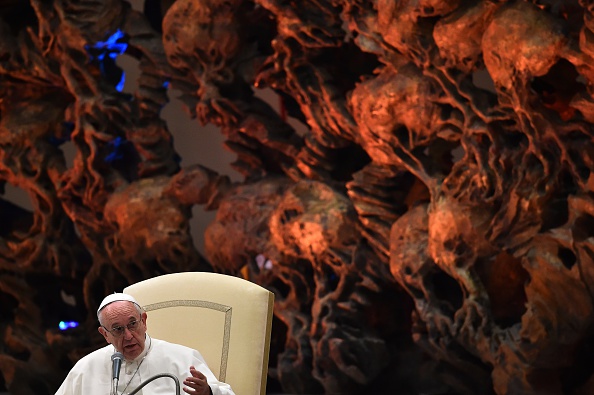
Darkness Visible: Eerie, shrieking skull-like faces seem to peer out menacingly from the base 0f La Resurrezione, an eight ton sculpture, as “Pope” Francis speaks during an audience on November 21, 2015 at the Paul VI Audience Hall at the Vatican. It is only one of the many bizarre things associated with this auditorium. (image: Getty Images/AFP / rights-managed)
by Francis Del Sarto
G.K. Chesterton once referred to architecture as “the most practical and the most dangerous of the arts.” When it comes to the dangerous part of the equation, church-related edifices built with Vatican II mandates in mind should all come with the spiritual equivalent of boarded-up doors and windows, and prominently-displayed “CONDEMNED — KEEP OUT!” signs.
One of the foremost offenders in this regard, and perhaps the creepiest looking of of all, has to be the 6300-seat snake-head-like Hall of the Pontifical Audiences. As construction on it was completed in 1971 during the ill-begotten reign of Giovanni Battista Montini (“Pope” Paul VI), the building is more popularly known as the Paul VI Audience Hall (or the Aula Paolo VI in Italian).
Inside, on the stage behind the seated “pope” is a massive artwork allegedly depicting the Resurrection of Christ. We say “allegedly” because, unlike in conventional renderings, there is no joy to be found in it, no angelic Alleluias! singing the praises of Our Lord’s victory over the grave. Rather, it could more likely be taken for a glimpse into the horrors of hell or perhaps some tragic pagan epic, than it could pass for a scene of Easter glories. Both the hall and the sculpture will be treated in depth momentarily, but first it will be profitable to examine the Novus Ordo justification for such grotesqueries.
“Vatican II changes everything.”
A number of architectural styles have been wildly popular over the past half-century or so: modernist, hyper-modernist, and post-modernist, chief among them. As for Catholic, not so much. One could even say there has been a concerted search-and-destroy effort to attack true Catholic churches whenever possible, either selling them to secular buyers or Protestant sects, levelling them to the ground in a scorched earth policy to usher in the Age of Strange, or gutting their interiors of all that made them worthy places for priests to offer the true Mass through a process that has been aptly described as “wreckovation”.
It would not be a stretch to say that post-Vatican II ecclesiastical architecture in many cases represents a deliberately anti-Catholic form of church design. The title of Michael S. Rose’s 2001 book on the subject pretty well describes those Modernist edifices: Ugly as Sin. Often it seems that the men designing those temples are deliberately seeking to make them as hideous and un-Catholic as they possibly can.
The title of this section is a quote by Father (or “Father”) Richard S. Vosko, a noted “liturgical design consultant” and wreckovator extraordinaire. He is a promoter of worship spaces for “happy people on the move”, and he “speaks reverently and respectfully of pagan cultic practices, but can barely say anything pertaining to the Catholic Church except by laughing uncontrollably”, as noted by the late Paul Likoudis in an article for The Wanderer in 2001. (Note that when a progressive speaks of “people on the move” or the popular Novus Ordo catchphrase, “a pilgrim people”, the moving does not denote a pilgrimage to, say, Rome or the Holy Land or to some indulgenced church or shrine — that would be a centuries-old traditional Catholic devotional practice. Rather, what is meant is the Modernist sense of Catholics moving from an orthodox belief system to an ever-evolving one, from the stability of immemorial objective truths to continually-mutating subjective experiences.)
So, when Vosko says that Vatican II represents “the end of stable religion”, it is most assuredly said in triumph. The Likoudis article already referred to showcases Vosko’s contributions to “Catholic” churches after the council and would be worth quoting in full. For copyright reasons, however, we must restrict ourselves to repeating only some salient portions (readers are encouraged to read the full text here):
In a revealing appearance April 3 [2001] at the University of Toledo’s Corpus Christi Chapel [see inside here], which he designed, Vosko bedazzled some 300 Toledo-area Catholics with his talk about building worship spaces for “happy people on the move,” showing himself as a man in movement.
…For 56 minutes, Vosko articulated his rejection of Christian teachings, his rejection of Catholic art, architecture, and ritual, his contempt for Catholics stuck in “old habits” of prayer and worship, as he attempted to explain what his new religion is all about.
In Vosko’s anthropological religion, the story of Jesus is a “myth” and Catholic rituals are not objectively different from Sioux sun dances or the Shamanic practices of Nepalese monks.
…He said “there’s a lot of debate in the Church,” because “some challenge the Church to a new direction” while “others cling to relics of a bygone era.”
…Art and architecture — said the art consultant for Roger Cardinal Mahony’s new cathedral and Bishop Matthew Clark’s cathedral renovation, among others — are only important insofar as they help people on their “inner search.”
How Corpus Christi helps people on their inner search is not clear. The edifice, described by one person in the audience as “very cerebral,” is appallingly stark. Except for the labyrinth in colored tiles on the floor, and the wood and upholstered chairs (no kneelers), the church’s sharp surfaces are entirely white, except for a two-story window, which frames the “sacred” pine tree just outside. A pyramid-shaped skylight at the peak of the church intensifies the whiteness. The chapel’s stations of the cross are set in the floor. A large granite immersion pool bubbles water in the gathering space. The overwhelming effect of Vosko’s edifice is that it would be more serviceable as a showroom for upscale sports cars.
…”Some people use tradition as a way of staying in a habit. We cannot stand still,” Vosko said as he continued walking around the labyrinth he designed into the floor of the chapel, “because life is too short.”
…During his lecture, Fr. Vosko expressed his preference for the church-in-the-round model, saying circles — citing Stonehenge, Indian tepees, and mandalas as examples — are powerful symbols, as is the labyrinth. He also defended Corpus Christi Chapel’s movable bare wooden cross, which he described as a “powerful totem that puts us in touch with that which can be.”
He told his audience that when he is retained as a consultant for a parish renovation, that “sometimes you have to strip away things … that get in the way, things that are just habits.”…
(Paul Likoudis, “Liturgical Design Consultant Reveals His New Age Religion”, The Wanderer, Apr. 26, 2001)
What Vosko says in explaining his approach is more or less echoed by the vast majority of his fellow architectural anarchists, including the Modernist mind behind Paul VI Audience Hall, whom we will meet in a few moments.
Lex orandi, lex credendi — how we pray reflects what we believe, and vice versa. Just as the Modernist infiltrators realized that the most effective way to “re-educate” the faithful into accepting a false religion cast as “up-to-date Catholicism” was by radically altering the way they worshipped, in the form of a “New Mass”, those changes had to carry over to celebrants discarding traditional vestments in favor of cheap, undignified ones (aka “horse blankets”), changing the furnishings of the church (replacing the altar with a table, moving or even hiding the tabernacle, removing altar rails and kneelers, etc.), and ultimately replacing pre-Vatican II churches with late-20th century specimens of spectacular bizarreness, the unwritten rule apparently being: The designer is to be given complete freedom in choosing whatsoever style most greatly pleases him, provided it fits in with the faith community, and is approved by the local authorities. However, under no circumstances may the finished edifice appear to be, much less be able to function as, a Roman Catholic church.
This has been made abundantly clear over and over again throughout the world, so much so that any number of pictorial essays have been published to decry the outrages. Thus, for example, we see on the semi-traditionalist Tradition in Action the appropriately-titled “Churches of Hell”, where one can see a “church” that looks like a dunce cap, another with weird angles out of some German expressionist movie, yet others resembling a Shinto shrine or some type of occult building, etc.
Do you like origami? The Japanese art of making decorative shapes from folded paper can produce some lovely works; unfortunately, it’s not something that really lends itself well to church design — quite the opposite, to be honest. However, that fact did not dissuade some determined German Novus Ordos from erecting an origami-style “rest stop for the soul” along the autobahn, as reported here at Novus Ordo Watch back in 2017.
That same year, we also reported on the disgraceful new “basilica” at Fatima, which constituted one of many Vatican II church attacks on the 1917 apparitions. We wrote: “The ugliness of it all speaks volumes: It is the architectural expression of the Novus Ordo religion. For this reason alone it cannot be anything other than ugly” (“Blasphemy at Fatima: The ‘Basilica of the Holy Trinity'”, May 22, 2017).
Even secular web sites don’t fail to see the obvious, such as Thrillist, which published a feature entitled “The Nine Ugliest Cathedrals in the World” (eight out of nine are Novus Ordo, with the last one being an oddball Anglican “Cardboard Cathedral” in New Zealand). Check them out at your own risk.
Circling back around to the primary subject of this article — the Paul VI Audience Hall — we can’t leave this section without noting that the designer of the hall, Pier Luigi Nervi (1891-1979), although a fairly prolific architect, was to our knowledge involved in only one other collaboration on a religious structure, the Cathedral of St. Mary of the Assumption, in San Francisco, California, which is quite hideous in its own right:
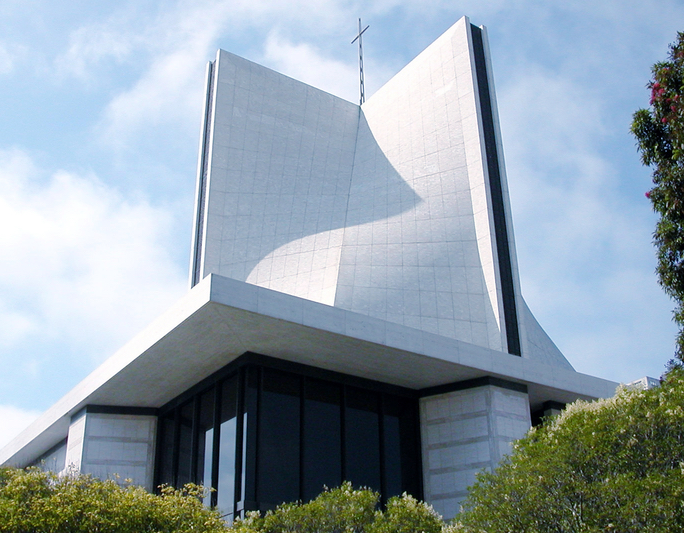
St. Mary’s Cathedral in San Francisco, aka “Our Lady of Perpetual Agitation”
(image: Wikimedia Commons / public domain)
According to the cathedral’s entry on Wikipedia: “The design process was controversial. A preliminary design reminded one critic of ‘the effort of a camel and donkey to mate.’”
Not all have given it a negative rating, however. Two years ago, the eclectic Architectural Digest ranked it among the nation’s prettiest, but even in reporting that fact, a San Francisco-based website saw fit to open the article with this gibe:
Know[n] to few as Church of Mary of the Assumption or Cathedral of Saint Mary of the Assumption, the church at 1111 Gough [Street] has been rechristened by San Franciscans as Our Lady of Maytag. (It also goes by the sobriquets “Our Lady of Perpetual Agitation” and “McGucken’s Maytag.”) One look at its washing machine agitator-like roof and you will see why.
(Brock Keeling, “Church of Mary of the Assumption named one of nation’s prettiest churches”, Curbed San Francisco, Feb. 7, 2017)
The McGucken of “McGucken’s Maytag” is Bishop Joseph Thomas McGucken (1902-83), who ordered the erection of a cathedral to replace the previous St. Mary’s, which had been destroyed by arson in 1962. The new one was designed while McGucken was in Rome attending the Second Vatican Council, and it has been called the “first cathedral truly of our time and in harmony with the liturgical reforms of the Council” — by architecht Nervi himself.
The Horrors of Hell Hall (CAUTION: Frightening images ahead)
Freak Shows & Buffoonery: In between the usual progressivist platitudes heard in the Modernist echo chamber known as Paul VI Hall, inane spectacles serve as diversions, but the frivolity masks a darkness: The hall was built with the express intention of replacing the Church’s “relics of a bygone era” with Vatican II’s “new direction”, and quite successfully so.
Not far south of St. Peter’s Basilica, only a stone’s throw away, one can find the Hall of the Pontifical Audiences, which was solemnly inaugurated on June 30, 1971. It resides partly in Vatican City but mostly in Rome, and the Italian part of the building is treated as an extraterritorial area of the Holy See.
The following video clip provided by the Associated Press shows “Pope Saint” Paul VI and Pier Luigi Nervi during the opening of the hall (the first minute of the video has no sound):
Commissioned in 1963, the auditorium was built on land donated by the Knights of Columbus. Construction began in 1966. Paul VI and his successors have used it as an alternative to St. Peter’s Square as a venue for Wednesday audiences or when the weather is inclement. It stands as an ongoing mocking reminder to Catholics by their enemies that “Sorry, folks, but we’re running things now!”
Controlling adversaries in such close physical proximity to the Vatican is in line with something ominously declared some time ago, namely, how “within the eight city blocks that make up the Vatican State no fewer than four Scottish Rite lodges are functioning… Many of the highest Vatican officials are Masons.” Before scoffers dismiss this as the wild rantings of a traditional Catholic “conspiracy theorist”, let it be known that the man making the statement, far from being one of the faithful, was Carlos Vazquez Rangel, Grand Commander of the Supreme Council of the Masons of Mexico, who proudly made the boast during an interview with the political journal Processo (see John K. Weiskittel, “Freemasons and the Conciliar Church”, in The Athanasian XIV, no. 4 [June 1, 1993]).
We’ve already seen the thoughts of Fr. Richard Vosko, the “liturgical design consultant” responsible for guiding wreckovation in American churches. What he had to say about the thinking behind Novus Ordo church architecture is equally apropos the Paul VI Masonic Audience Hall: “Vatican II says we have to have a totally new understanding of what religion is.”
Architect Nervi was in complete harmony with this “new understanding”, which, when it came to sacred spaces, was to stand traditional thinking square on its head and to serve as “a challenge to conventional religious thought”. (It is noteworthy that one of his other chief projects assisted the aims of world government, when he was one of three architects who designed the UNESCO Headquarters aka the World Heritage Centre, which was completed in Paris in 1958.)
From an analysis of the Paul VI Audience Hall, we read:
Nervi’s Audience Hall is, at its core, an intersection of two profound ideas in his life’s work—the relentless search for the “truthful style” and the creation of an architecture of optimism. In a broader sense, the building serves to challenge (and ultimately redefine) ideas of what sacred architecture can and should be.
A prime example of this challenging or rethinking can be found in the material choices for the Audience Hall—
“Every element in the structure is in fact made of white cement, blended with special inert matter containing fragments of Apuan marble. All the surfaces are left exposed and no finishing material is used, ensuring that cement, traditionally considered a poor, sad material, is here given the same worth as the precious stones employed in the nearby basilica.”
…
Nervi’s decision to leave the ferrocemento unfinished has roots in modernist theory. Huxtable sees structure as “the basis of modern architecture.” If this is in fact the case, then Nervi’s work represents a clear articulation of modernist principles and perhaps even the “truthful style” he sought throughout his career. The materiality of the Paul VI Audience Hall is also a challenge to conventional religious thought, particularly pertaining to the design of sacred spaces. Nervi’s use of concrete, a “poor, sad material,” is no accident. It is a commentary on the futility of relying on precious materials to create a sense of the divine—in his Audience Hall, Nervi demonstrates that space achieves sanctity through structure and thoughtfully designed spaces, not expensive skins or claddings.
(Billy Griffits and John David Scott, “1971 Paul VI Audience Hall”; posted at Florida International University, n.d.)
Nervi’s style choices anticipate “Pope” Francis’ championing of what’s been referred to as the “church of the poor”, or the “miserablist church”, based on a Modernist postulate that the Church must be unadorned, as displays of pomp and grandeur are an affront to the needy. But not only, it is argued, should she eschew solemnity and dignity, she should consciously present a plain, even shabby, appearance, as achieved by Nervi as a statement against the Church’s architectural tradition. Yet, far from being an affront to the poor, the beauty of the churches were meant to give them a respite from the misery of their everyday lives, to give them a foretaste of Heaven, their true goal.
All of this reminds one of the lament of Cardinal Eugenio Pacelli, the future Pope Pius XII, which goes in part: “I hear all around me innovators who wish to dismantle the Sacred Chapel, destroy the universal flame of the Church, reject her ornaments, and make her feel remorse for her historical past” (Mgr. Georges Roche, Pie XII devant l’Histoire [Montréal: Éditions du Jour, 1972], p. 52; trans. by Christopher Ferrara).
In recent years, the Vatican’s audience hall has become the subject of much scrutiny on the internet. Many critics, Catholics and non-Catholics alike, have raised questions about the weird, snakelike features of the building, both inside and out. It’s one of those things that, once seen, can’t be unseen.
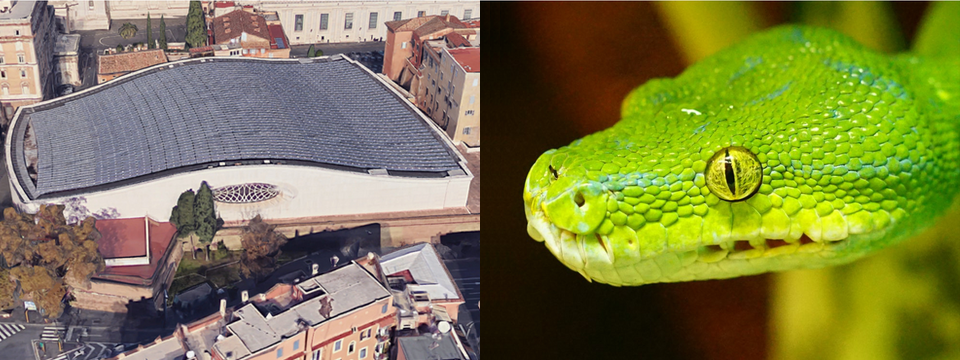
The exterior shape of the building has been likened to the head of a pit viper, a resemblance enhanced in 2008 when its roof was retrofitted with photovoltaic panels. Yet it’s only after one goes inside that the full effect can be appreciated. If one stands at the far end of the hall and looks all the way down to the stage at the other end, where Francis and his four immediate predecessors have given their Modernist pep talks, there’s what looks like a gigantic viper staring back at one with the windows as the elliptical eyes so characteristic of the Viperidae family of reptiles. The stage is the mouth with pillars to either side of the middle shaped like fangs, the center aisle for a tongue, and the design of the ceiling and walls reminiscent of snake skin.
Indeed, visitors who wander into the hall initially unaware of its function could be excused for mistaking it for a museum of herpetology. If an architect had tried to give it that viperous visual effect, it’s not clear what he would have done differently. Have a look:
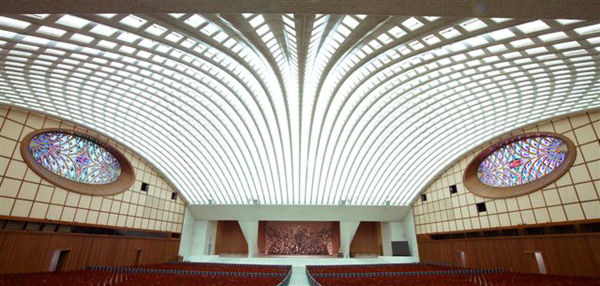
Any resemblance to the face of a viper is entirely accidental… 😉

Tradition in Action devoted one of its “Church Revolution in Pictures” features to the subject, in a post aptly entitled “Teaching from the Serpent’s Mouth”. After describing how different areas in the hall’s interior are suggestive of the reptile, the following cogent point is made:
If these analogies are objective, the Pope [sic] stands precisely in the center of the serpent’s mouth. It is from there that he delivers his speeches during his general audiences and special meetings. Quite different from speaking from the chair of Peter, the cathedra of truth. The conciliar Popes now deliver their new doctrine from the serpent’s mouth.
For those who may be unaware of the significance of speaking through the mouth of a serpent, the last such incident was recorded in Genesis 3:1-5. Spoiler alert: It didn’t work out too well.
In any case, there has naturally been no shortage of would-be debunkers. Some have written off the effect as merely created by the distortion of a photo taken using a fisheye lens. The trouble with that is that by doing an image search of the hall, it becomes abundantly clear that while such a lens would certainly increase the effect, there are simply too many photos showing the same effect that it would be a conspiracy in its own right to suppose that they were all taken with a fisheye lens or otherwise distorted, independently of one another and for no apparent reason. No, even Vatican Media itself publishes photos showing this viperous look, as can be seen in this picture of Francis’ Jan. 2, 2019 audience.
We can even see this effect in a shot taken from inside the building as construction was in progress. No optical effects, just a standard lens:
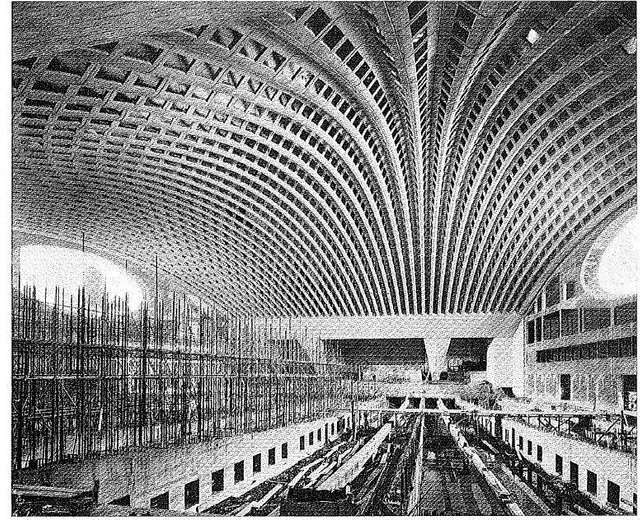
(image: arcvision.org / fair use)
For some perspective, here’s a shot from the back corner:
Next is another straightforward look down the center aisle:
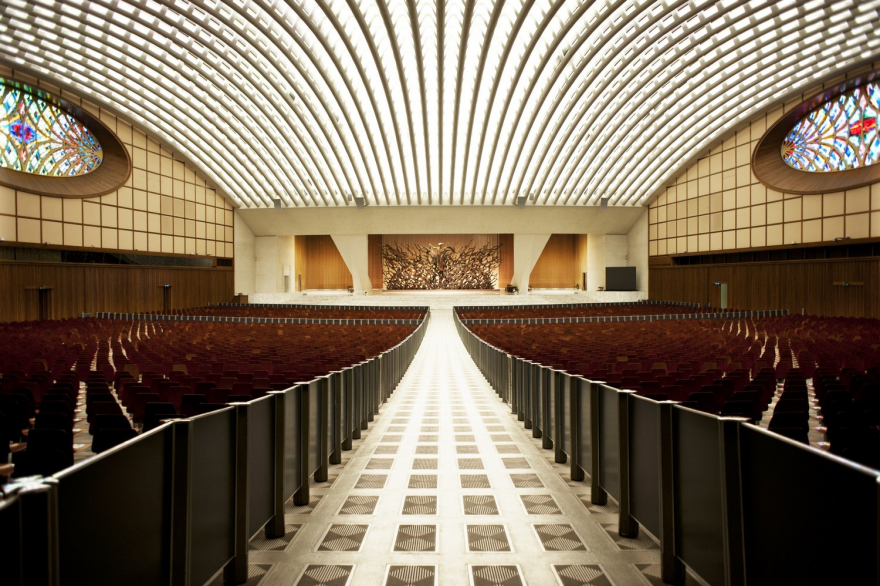
(image: Manuel Chacón-Palomares at historia-arte.com / CC BY 4.0)
Interestingly enough, just on the very day of the release of the present article, the following photo was shared on Twitter by Vatican journalist Arthur Herlin. It depicts the auditorium having been transformed into a giant playground for the children of Vatican City employees. Once again, the reptilian vibe is present:
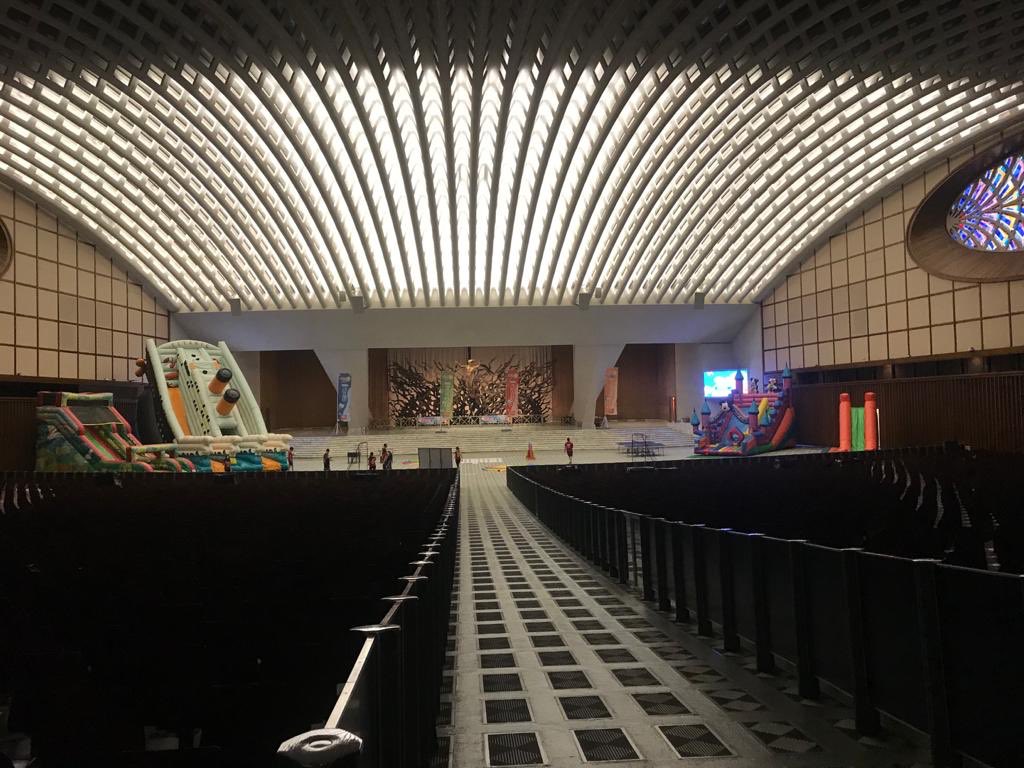
(image: twitter.com/arthurherlin / fair use)
The hard-t0-miss “there’s a viper staring at you” effect is no doubt attributable in large part to the trapezoid shape of the building. Yes, you read that right: The edifice was not built in the shape of a rectangle but of a trapezoid (trapezium). This is highly significant because the trapezoid is considered the most Satanic of shapes in occultism, perhaps because its visual discordance — and frequent asymmetry — lends itself to disorientation and disharmony. For obvious reasons, we’re not going to link to Satanic web sites or to sites where Satanic rituals are explained, but suffice it to say that there is a Law of the Trapezoid and an Order of the Trapezoid connected with Satanism and occultism. People who must know about these things can do their own research.
The point is not that a trapezoid shape is bad in itself — it obviously isn’t — but that Satanists have a preference for its use and consider it highly suitable for their practices. They believe that it facilitates the demonic, that it gives certain energies to those who are sensitive to it, etc. Just as there is Catholic architecture, which uses shapes and designs that are particularly suited to the sacred worship of the Holy Trinity, so there is also anti-Catholic architecture, Satanic building design, which those pitiful souls use for their nefarious ends.
As far as the Paul VI Hall goes, its trapezoidal shape is hard to miss when viewed from above:
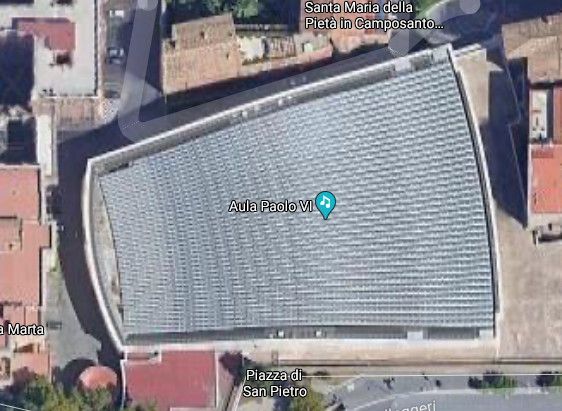
image: Maxar Technologies (fair use) via Google Maps street view (screenshot)
Occultists’ love of the trapezoid would explain why some Novus Ordo altars are made in that shape and why — get this — “Pope” John Paul II’s body was placed in a coffin that was trapezoidal in shape, not merely when viewed from the top but also when viewed from the side. This is hardly an accident, and it speaks volumes. Of course the interreligious “meditation room” of the United Nations headquarters is also trapezoidal in shape.
Thus, it isn’t all that surprising that, once the Modernists had usurped the See of St. Peter, the first chance they got to build an auditorium meant to be a venue for papal events in the heart of Catholicism, they made it trapezoidal, odd, and sinister.
Still, some will write off the snake-head-like appearance of the building as some observers simply having overactive imaginations, seeing what’s not there — an example of the psychological phenomenon known as pareidolia (perceiving meaningful connections in unrelated objects, such as animals in clouds, a grinning face in a car’s grill and headlights, etc.). Like a Rorschach test, “conspiracy theorists” are just projecting their delusions. Nervi would never have intended to fashion something that looks like the head of a serpent, and, clearly, not everyone sees it. Right?
Granted, the human mind does tend to arrange unrelated objects to signify something else. But the arranging can come not only from the observer, it can also come from the designer. No one knows if Nervi had such an uncanny conception; but whether or not it was intended, the design easily lends itself to such an interpretation; and it is not unreasonable, given everything that has transpired in the Vatican since the death of Pope Pius XII in 1958, to point out that perhaps there is more than just inexplicable “oddity” here — perhaps there is deliberate Satanic intent.
But whatever the case may be, what definitely no one sees inside that barren hall is anything that in the least identifies it as being Catholic: There are no crucifixes or crosses, no religious paintings, no statues, or anything else to raise the heart and mind to God. Now that is not up to interpretation — the striking absence was a deliberate attempt by those tasked with furnishing the hall to reject Catholic ornaments (with one exception, to be mentioned shortly).
“Wait”, some Novus Ordo stalwarts may chide us, “how can you possibly overlook the striking artwork that’s situated directly behind the pope, and that rises high above him”?
Yes, how indeed does one miss a two-story-high elephant in the room?
A Frightful Centerpiece of Blasphemy and Sacrilege
Christ or Antichrist? Looming menacingly above Benedict XVI, and looking more like a creature from a horror film than the Savior of mankind, is what the artist described as Jesus Christ emerging from amid toxic smoke (“smoke of Satan”?) and human skulls after a nuclear Armageddon.
In 1977, on the occasion of Paul VI’s eightieth birthday and less than a year before his death, the Vatican was gifted with an enormous bronze sculpture that would prove to be the hall’s finishing touch. La Resurrezione (“The Resurrection”) is a Modernist nightmare image that shrieks the message of blasphemous rebellion stated somewhat less shrilly by its surroundings. As Atlas Obscura, a website dedicated to unusual places around the world, puts it: “If you want to talk to the Pope you will have to stare down this surreal vision of Jesus rising from a nuclear hell”; while another site, Lazer Horse, describes it as “intriguingly sinister”.
Elsewhere, comments randomly found around the internet use terms like “bizarre”, “frightening”, “ugly”, “ghoulish”, a “monstrosity”, “evilly horrific”, “demonic”, “gruesome”, “terrifying”, “depressing”, “strikingly weird”, “dark”, “oddly nightmarish”, and “Satanic looking”. So, suffice it to say, no one’s going to confuse it with the spiritually uplifting works of great Catholic artists from the past. But why must it be so diametrically opposite to the spirit of true sacred art? The compulsion to debase that which is holy, inherent in theological Modernism, necessarily carries over to its counterparts in other fields — it cannot do otherwise.
La Resurrezione replaced the original (and traditional) artwork that served as the backdrop for the audiences the first few years (it can be seen in the video from the Associated Press embedded above). In 2011, it received restoration work, lest this priceless treasure be lost to posterity. Unlike Pier Luigi Nervi, who seemingly left no specific clue as to whether there was any extra-architectural significance to the hall’s design, La Resurrezione‘s creator Pericle Fazzini (1913-1987) was quite specific when speaking about the message he intended to send with it. An obituary in The New York Times reports:
The Vatican commissioned Mr. Fazzini to provide a work for its modern auditorium. The result was “The Resurrection,” a statue depicting Jesus rising from a nuclear bomb crater.
“Suddenly there came to me the idea of Christ preaching peace for 2,000 years, and the place where He prayed for the last time: the olive grove of Gethsemane,” said Mr. Fazzini in a book about the work. “I had the idea of depicting Christ as if He were rising again from the explosion of this large olive grove, peaceful site of His last prayers. Christ rises from this crater torn open by a nuclear bomb; an atrocious explosion, a vortex of violence and energy.”
“The Resurrection” is molded in red bronze and yellow brass and measures 66 feet by 23 feet by 10 feet.
(“Pericle Fazzini, 74, a Sculptor for Vatican”, The New York Times, Dec. 5, 1987)
According to the Wikipedia entry for the abominable piece, “The original work was done in polystyrene and the fumes of the burning plastic gave Fazzini a blood clot during its production.” Talk about the smoke of Satan!
Setting Christ’s Resurrection in an ahistorical, fictionalized late 20th century is quintessentially Modernist, because it is art that, supposedly, speaks to modern man. This was touched upon at Vatican II, when Gaudium et Spes, the council’s so-called Pastoral Constitution on the Church in the Modern World, declared:
The Church acknowledges also new forms of art which are adapted to our age and are in keeping with the characteristics of various nations and regions. They may be brought into the sanctuary since they raise the mind to God, once the manner of expression is adapted and they are conformed to liturgical requirements.
Thus the knowledge of God is better manifested and the preaching of the Gospel becomes clearer to human intelligence and shows itself to be relevant to man’s actual conditions of life.
(Second Vatican Council, Pastoral Constitution Gaudium et Spes, n. 62)
Fazzini’s final work, dedicated in 1987, was a hideous monument to Padre Pio at San Giovanni Rotondo. You can view it here. It’s not quite as overtly sinister as his unorthodox take on the Resurrection, but every bit as peculiar (we can’t believe that the holy stigmatized spiritual son of St. Francis would be thrilled at this rendering of him, though he would take solace in knowing that he had undergone a similar indignity in bronze as his Divine Master).
Returning to La Resurrezione, as disturbing as it is when viewed from afar, it is no less so seen up close, especially when we zoom in on the head that’s allegedly that of Christ:
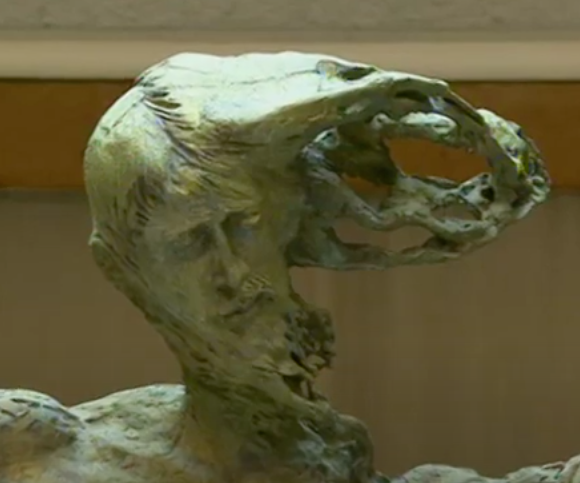
image: youtube.com (screenshot / fair use)
Rather than Our Blessed Lord displaying the expression of one who has conquered sin and death and risen triumphantly from the grave, Fazzini’s version gives this “Jesus” a world-weary look of uncertainty and perplexity. It isn’t an expression that exactly strengthens the belief, devotion, and resolve of the faithful. Instead, the befuddled look they see upon that countenance manifests the doctrinal flux and confusion that overcame Catholics post-Vatican II, when they found themselves faced with a new religion emanating from what appeared to be the Catholic magisterium.
Beyond that, there is something else that brings this further into the creepy zone. It has been pointed out that the rather scraggly hair billowing out on the right of the photo when taken as a whole, bears a resemblance to a serpent’s head, so we’re back to the reptile connection again.
And then there is the odd coincidence someone found that when mirroring the left side of the statue, there appears something that looks eerily similar to the head of the Satanic Baphomet:
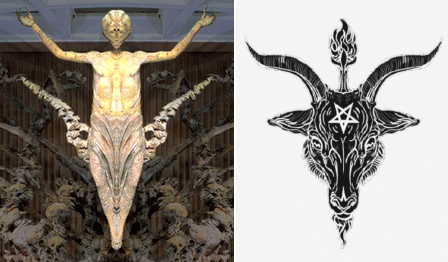
images: lazerhorse.org (cropped) and etsy.com (fair use)
Some may say that’s straying too far down the rabbit hole, but at what point do the number of seemingly meaningful correlations connecting the hall and sculpture to diabolical symbolism reasonably cease to be coincidences and suggest deliberate planning?
And to throw in a distinctly sedevacantist what if?, there’s a certain conspiracy theory centered around the year 1958. This is just meant as a bit of fun speculation, but according to the so-called Siri Thesis, in that year Genoa’s Cardinal Giuseppe Siri was elected pope but was pressured to resign before he could appear on the balcony of St. Peter’s. According to one version, he was forced out by being told that if he didn’t, a nuclear strike would be launched on Rome, wiping out the Vatican and the entire college of cardinals, which was gathered there in conclave. As a result of his resignation, the suspected Rosicrucian Freemason Angelo Roncalli became Antipope John XXIII — and the rest, as they say, is history.
Following this hypothetical narrative, La Resurrezione would represent a celebration of the triumph of the 1958 coup, with the nuclear blast representing the threat through which occult forces were able to seize the reins of the Church, and the “risen Christ” (Antichrist?) representing the emergence of the Novus Ordo Sect — with a “New Resurrection” leading the way to a “New Pentecost”.
The occult connection to this? The excommunicated apostate Paul Roca (1830-1893), who had once been ordained a Catholic priest, had boldly predicted the takeover of the Vatican by dark forces, as though he had preternaturally obtained foreknowledge of Satan’s plan to destroy the Church. Roca, three of whose works can be found on the Index of Forbidden Books, wrote infamously:
I feel that divine worship, as regulated by the liturgy, ceremonies, rites, and rulings of the Roman Church, will suffer a transformation soon, at an ecumenical council. It will return the Church to the venerable simplicity of the apostolic golden age, and harmonize it with the new stage of modern conscience and civilization.
(Paul Roca, Abbé Gabriel; quoted in Rev. Joaquín Sáenz y Arriaga, The New Post-Conciliar or Montinian Church [La Habra, CA: Edgar A. Lucidi, M.D., 1985], p. 194; italics given. Fr. Sáenz y Arriaga‘s book was first published in the original Spanish in 1971.)
What Roca describes in this quote is, of course, precisely what was accomplished by the subversive Second Vatican Council in the 1960s. (Of particular interest in this passage is how Fr. Annibale Bugnini, the chief architect of Paul VI’s “New Mass”, seems to have used it as part of his playbook in developing his liturgical revolution, as he too said the Church must restore the ancient norms, while contradictorily claiming to also seek to harmonize it with modern man, as though the aims were somehow compatible.
In his book Glorious Centennial, Roca wrote in the manner of the Modernists, à la Teilhard de Chardin, about an “evolving” Jesus. His choice of language in the passage is highly suggestive of the sculpture’s figure emerging from the radioactive gusts swirling around him: “Nobody will be able to stop Christ’s whirlwind,” he wrote (quoted in Sáenz y Arriaga, The New Montinian Church, p. 187; see scan here). Obviously, the Christ he had in mind is an occult counterfeit.
And that is obviously also the “Christ” of La Resurrezione:
The Vatican likes to use its audience hall also for concerts and similar events. The embedded photo carousel above shows images of La Resurrezione lit up for the occasions.
“And he laid hold on the dragon the old serpent, which is the devil and Satan….”
This section heading is a quotation from the twentieth chapter of the book of the Apocalypse (verse 2), in which St. John speaks of an angel binding the devil, casting him into the bottomless pit for a thousand years and sealing him there so he can no longer seduce the nations. Once the thousand years are past, Satan is set loose to work evil again, but the good news — such as it is — is that it will be only for “a little time” (v. 3). Yet he will make up for his lack of time by amassing a vast army — “the number of whom is as the sand of the sea” (v. 7) — to wage war against the faithful. This ties in with what St. Paul writes in one of his letters to the Thessalonians: “And now you know what withholdeth, that he may be revealed in his time. For the mystery of iniquity already worketh; only that he who now holdeth, do hold, until he be taken out of the way” (2 Thess 2:6-7).
God and His Church, however, will prevail. Satan and his minions shall lose decisively, and he, along with the beast and the false prophet, will suffer forever in a pool of fire and brimstone, after which comes the General Judgment (see Apoc 20:9-15; 2 Thess 2:8).
Where are we on this timeline? No one can say with certainty which milestones have been passed and which are still ahead, but given the state of the Church and the world, it’s probably safe to say we’re quite far along. In 1957, when interviewed by the Mexican Fr. Augustine Fuentes at her convent in Coimbra, Portugal, Sister Lucy of Fatima spoke with great gravity about the future. After stating that the Blessed Virgin Mary was sad because her message at Fatima wasn’t being heeded, Lucy declared:
But believe me, Father, God will chastise the world and this will be in a terrible manner. The punishment from Heaven is imminent.
…
Father, the devil is in the mood for engaging in a decisive battle against the Blessed Virgin. And the devil knows what it is that most offends God and which in a short space of time will gain for him the greatest number of souls. Thus the devil does everything to overcome souls consecrated to God because in this way, the devil will succeed in leaving the souls of the faithful abandoned by their leaders, thereby the more easily will he seize them.
(Sister Lucia of Fatima, Interview with Fr. Augustine Fuentes, Dec. 26, 1957; quoted in Frère Michel de la Sainte Trinité, The Whole Truth About Fatima, vol. III: The Third Secret [Buffalo, NY: Immaculate Heart Publications, 1990], pp. 504-505; underlining added.)
Now, while there is always going to be some debate as to whether a spiritual or a material chastisement is meant, it is the opinion of the present writer that there is no reason to necessarily conclude it must be only one of the two. Sister Lucy says God is to punish the world in “a terrible manner”, and how terrible would it be for there to be multiple fronts with which to deal, rather than but a single one? She very well could have had in mind a Pandora’s box out of which many evils would spring, so richly deserved by a world that has largely abandoned God and refused to heed Our Lady of Fatima’s call to repentance.
Regardless, there certainly cannot be much debate as to the meaning of the punishment being imminent. Whatever the nature of the punishment or its precise timeframe may be, “imminent” certainly doesn’t mean “many decades from now”. No, a reasonable inference is that when Lucy said “imminent”, she meant “right around the corner.” Just ten months after she made this statement, the fateful papal conclave was assembled to elect a successor to Pope Pius XII. Incidentally, in the same interview, she told Fr. Fuentes that Russia would be used by God as “the instrument of chastisement chosen by Heaven to punish the whole world”.
The punishment from Heaven was indeed imminent, and it involved God allowing permission for a coup d’état in which a false pope would be installed. (Returning to the Siri thesis for a moment: It is Russia that is speculated to have made the nuclear threat.) This silenced the voice of St. Peter at the Basilica that bears his name and set in motion a tidal wave of Modernism that changed virtually every facet of Catholicism by means of a false council, false sacraments, false canon law, false annulments, etc. Most of these things took place during the 1963-78 reign of the very man for which the Paul VI Audience Hall was named, and this was possible only because he was a false pope and thus the divine protections guaranteed for the Papacy were not verified in him.
Also set in motion at the robber conclave of 1958 was the phenomenon Sister Lucy noted when she talked about how “the devil does everything to overcome souls consecrated to God”. Within a decade there broke out the spiritual pandemic that is still afflicting the Church and the world today, and which is so amply documented on this web site.
Behind Francis: Ghoulish detail of La Resurrezione up close
The 2002 article “An Index of Catholicism’s Decline” by Patrick J. Buchanan uses the cold, hard statistical facts to spotlight the fruits of the Vatican II revolution: a rapid decline of priests, nuns, brothers, and seminarians, along with dwindling Mass attendance; a steep increase in marriages being declared null; “Catholic” school closings; and opinion polls showing a majority of “Catholics” who don’t believe in the Real Presence of Christ in the Eucharist or in the necessity of confession. At the same time, acceptance of the so-called “divorced-and-remarried” as legitimate spouses grew, and of course the sinful practice of artificial birth control was not only declared acceptable but also used by most, and so the two-child family became the norm. Even the horrendous crime of abortion, the logical consequence of the acceptance of contraception, began to lose its stigma, to such an extent that today there are countless “Catholics” who either accept it as morally legitimate or at least defend it as a civil “right”, with no punitive consequences by the people who claim to be the lawful Roman Catholic authorities.
All of this came on the heels of Vatican II, which closed in 1965. Truly, in the Fatima seer’s words, “the souls of the faithful [had been] abandoned by their leaders”. Worse yet, the people who once had been their legitimate leaders remained in their positions and did the revolution’s bidding, and those who refused were replaced. Either way, then, the de facto “Catholic” hierarchs were the “false apostles [who] are deceitful workmen, transforming themselves into the apostles of Christ” (2 Cor 11:13), as St. Paul warned. They were “the hireling [who] hath no care for the sheep” (Jn 10:13), in the words of our Blessed Lord, and the situation persists to this day.
On top of that, we have the famous incident of Pope Leo XIII’s vision of a conversation between Christ and Satan, in which the devil was granted more power to destroy the Church. It was part of a vision the Pope is said to have had that led to the composition of the Prayer to St. Michael the Archangel that Catholics are accustomed to recite after Low Mass. This vision is described, among other sources, in a 1935 booklet published by a Benedictine priest:
A rather peculiar circumstance induced Pope Leo XIII to compose this powerful prayer. After celebrating Mass one day he was in conference with the Cardinals. Suddenly he sank to the floor. A doctor was summoned and several came at once. There was no sign of any pulse-beating, the very life seemed to have ebbed away from the already weakened and aged body. Suddenly he recovered and said: “What a horrible picture I was permitted to see!” He saw what was going to happen in the future, the misleading powers and the ravings of the devils against the Church in all countries. But St. Michael had appeared in the nick of time and cast Satan and his cohorts back into the abyss of hell. Such was the occasion that caused Pope Leo XIII to have this prayer recited over the entire world at the end of the Mass.
(Rev. Celestine Kapsner, O.S.B., Begone Satan! [Collegeville, MN: Celestine Kapser, 1935], p. 24)
More detail regarding the actual content of the vision is related by Fr. Domenico Pechenino (1873-1950) in the Mar. 30, 1947 edition of La Settimana del Clero (p. 2):
…This is what happened. God had shown Satan to the Vicar of His divine Son on earth, just like He did with Job. Satan was bragging that he had already devastated the Church on a large scale. In fact, these were tumultuous times for Italy, for many nations in Europe, and a bit around the world. The freemasons ruled, and government hadn’t become docile instruments. With the audacity of a boaster, Satan put a challenge to God. — “And if you give me a little more freedom, you could see what I would do for your church!” — “What would you do?” — “I would destroy it.” — “Oh, that would be something to see. How long would it take?” — “Fifty or sixty years.” [–] “Have more freedom, and the time that you need. Then we’ll see what happens.”
(Translation taken from Kevin J. Symonds, Pope Leo XIII and the Prayer to St. Michael [Boonville, NY: Preserving Christian Publications, 2015], p. 44.)
In 1946, the Archbishop of Bologna, Cardinal Giovanni Battista Nasalli Rocca di Corneliano (1872-1952), related the “historical explanation” for the line in the St. Michael’s prayer that mentions that the demons “prowl about the world for the ruin of souls.” He had received it from Mgr. Rinaldo Angeli, Pope Leo’s long-time personal secretary: “Pope Leo XIII truly had a vision of demonic spirits, who were gathering on the Eternal City (Rome). From that experience — which he shared with the Prelate and certainly with others in confidentiality — comes the prayer which he wanted the whole Church to recite” (Nasalli Rocca di Corneliano, Dio — L’Uomo — Il Diavolo, 2nd ed. [Rome: Figlie della Chiesa, 1951], p. 20; trans. by Bryan Gonzalez).
Some sources claim that the timeframe the devil was given to attempt to destroy the Church is 75-100 years, but since it is not known what year should mark the starting point anyway — it is reasonable, but by no means necessary, to assume that it was the year of the vision — the discrepancy is not that important.
What adds to the difficulty is that the exact date of Pope Leo’s vision is disputed. However, if it happened on Oct. 13, 1884, as some assert, it would mean it took place exactly 33 years before the miracle of the sun at Fatima. Novus Ordo writer and researcher Kevin Symonds concludes that, based on his findings, we may “surmise that the vision may have taken place sometime between January 6, 1884 and August, 1886…” (Pope Leo XIII and the Prayer to St. Michael, p. 29).
Regardless of the precise start and end dates, we have certainly all been able to see the effects of this diabolical power surge, however long it lasted. In fact, it is possible that Pope Leo’s quick reaction to the matter — his institution of the St. Michael’s prayer to be recited throughout the Universal Church — actually delayed the start date for a significant amount of time.
Some may object that even if we assume as much as 100 years’ duration and start from the year of the vision, it would mean that after 1984, or perhaps 1986, the devil’s power was taken away again, which hardly jibes with our experience. However, this leaves out of account the fact that according to the alleged vision the devil received an increase of power for however many years, so it would merely be the additional power that would be taken away from him after the allotted time has elapsed.
Another point to be made is that while Satan still retains plenty of power after — just not as much as over that time span — it cannot be forgotten that he was able to build a tremendous amount of momentum for evil during those years. Thus he now has a huge army of human sycophants happily carrying out his agenda — some of them consciously and maliciously, others as useful idiots, some indifferently, and still others under the diabolical delusion that they are doing the work of God (cf. Jn 16:2).
But whatever the case may be about this or that alleged vision or other private revelation, the objectively verifiable facts demonstrate beyond doubt that a new religion has been established in the Vatican since 1958, a religion that is Masonic and Naturalist in essence, a religion that despises Catholicism. It is, quite manifestly, a religion that expresses itself in art and architecture such as can be seen in the dreadful “hell hall” that is the Paul VI Audience Hall in the Vatican.
Vatican II really did change everything, didn’t it?




No Comments
Be the first to start a conversation